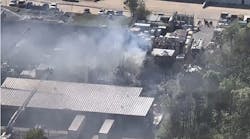July 14--For the gravely injured, a ride on a medical helicopter could mean the difference between life and death.
But it's an expensive trip, with an average ride costing about $20,000.
In an era of rising medical costs, the use of medical helicopters already was controversial before a series of fatal crashes added attention, culminating in one of the state's four medical helicopter companies having its accreditation suspended last month.
EagleMed, a Kansas-based company that operates in Oklahoma, continues to fly patients even though the Commission on Accreditation of Medical Transport Systems suspended the company's accreditation after a June 11 crash near the Choctaw Nation Health Care Center in Talihina. A patient died in the crash, and three crew members were injured.
Deadly crashes
According to a preliminary National Transportation Safety Board report, the aircraft's rotor blade disk struck a metal light pole, causing the pilot to lose control.
The accident was the third deadly crash the company has had since 2010.
In February, another EagleMed helicopter crashed on St. Ann Drive in Oklahoma City, narrowly missing nearby St. Ann Retirement Center and St. Ann Nursing Home. The pilot and a flight nurse died in that crash, and flight paramedic Billy Wynne was critically injured.
Wynne, 31, suffered burns on 60 to 65 percent of his body, a broken ankle, a broken leg, several broken ribs, a crushed spine, a broken sternum, and a broken arm, according to a Facebook page dedicated to his recovery.
Wynne was taken to Parkland Hospital in Dallas and then to Zale Lipshy University Hospital in Dallas for treatment, surgery and recovery. Recently he was transferred back to Oklahoma City, just in time for the birth of his second child. He is being treated at Integris Baptist Medical Center.
Another EagleMed helicopter crashed in 2010 in a pasture near Kingfisher. That crash killed two crew members and severely injured a third. A final NTSB report on the crash found the pilot was pretending to hunt coyotes when the helicopter hit a tree and plummeted to the ground.
A spokesman for the Commission on Accreditation of Medical Transport Systems said the pattern of crashes is alarming. The group will conduct its own investigation of the crash, and EagleMed will have to go through a supplemental accreditation process to win back its approval.
Accreditation is not required to operate in Oklahoma, and EagleMed is still flying patients.
EagleMed spokesman Robbie Copeland said the company is working with National Transportation Safety Board officials and the Federal Aviation Administration as they continue investigating the June and February crashes.
"If there is something we can do differently, we certainly will as soon as we have knowledge of the cause," Copeland said. "All I can tell you is the NTSB report is out for the accident in July 2010. As far as the other two, we won't know until the final reports are out from the NTSB."
About helicopter use
Most hospitals accept patients flown by helicopter the same as those brought by an ambulance.
The companies that operate the helicopters are privately owned and run, just like most ambulance companies. The hospitals have landing pads available to accept patients, but they do not operate helicopters themselves, said Brooke Cayot, spokeswoman for Integris Baptist Medical Center.
"It's a clinical decision," she said. "If it is an accident scene, a firefighter or an EMS crew could initiate a helicopter. They set it in motion. Whichever helicopter service has been initiated will call us and give us a report on what is coming in and when they expect to arrive."
Patients sometimes are flown between hospitals when a patient needs specialized care. In that case, it is up to a doctor to decide that a helicopter is needed instead of an ambulance, Cayot said.
"We get a lot of burn patients from some of our rural hospitals," Cayot said. "That is totally a clinical decision."
OU Medical Center operates a bit differently. Because it is the state's only level one trauma center, the hospital maintains its own medical helicopter through a Colorado company called Air Methods, hospital spokesman Eric Ferguson said.
"They basically maintain the helicopters and operate them specifically for us," he said.
Because medical helicopters are used only when a doctor determines it is necessary, they are usually covered by insurance companies, just like an ambulance ride would be, officials said.
Study of the industry
Faculty from the University of Oklahoma's emergency medicine department completed a study last year looking at the state's medical helicopter industry after a request from the state Health Department.
The authors of the study found there is a real benefit to using helicopters instead of ambulances in time-critical medical emergencies.
In addition to cutting the travel time to a hospital, helicopters allow medical workers to perform more advanced procedures. The study said the capabilities of a crew on board a medical helicopter are closer to a typical emergency room than an ambulance.
The study's authors found the cost of a typical medical helicopter ride is about $20,000, but the benefit they offer to critically ill patients generally is worth the cost.
But the risks highlighted by recent crashes complicate the issue.
"The available evidence does not suggest that (medical helicopters) pose any medical risks to patients that are significantly greater than the risks of ground transport," the study said. "Aviation risk is a different matter."
The report, which was completed before the two most recent EagleMed crashes, found the medical helicopter industry averaged about 13 crashes a year from 1988 to 2010, with about a third of those crashes resulting in a death.
And although the number of crashes has increased in recent years, the increase is related to the more common use of helicopters. The study found the accident rate for medical helicopters has been stable about 2 to 3 per 100,000 flight hours.
The authors of the study recommended accreditation be required for companies to operate medical helicopters in the state. They said the safety of helicopter emergency medical services (HEMS) should be continually monitored, and the public will have to decide whether the benefits are worth the risk.
"The stakes are high: if HEMS is really 'unsafe' at an unacceptable level, then operations should not proceed even if some patients' lives would be saved," the study said. "In our opinion, the data indicate a real risk, but not one that should be invoked to shut down HEMS."
CONTRIBUTING: Staff Writer LeighAnne Manwarren
Copyright 2013 - The Oklahoman, Oklahoma City





